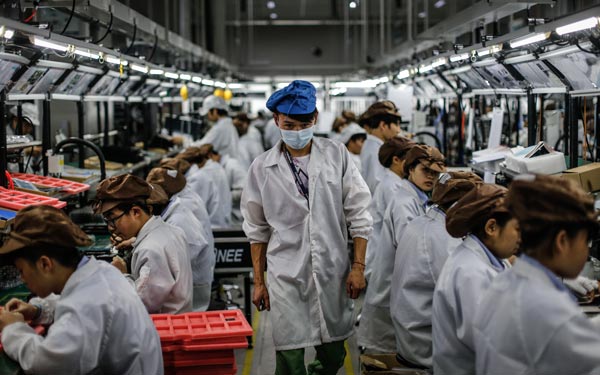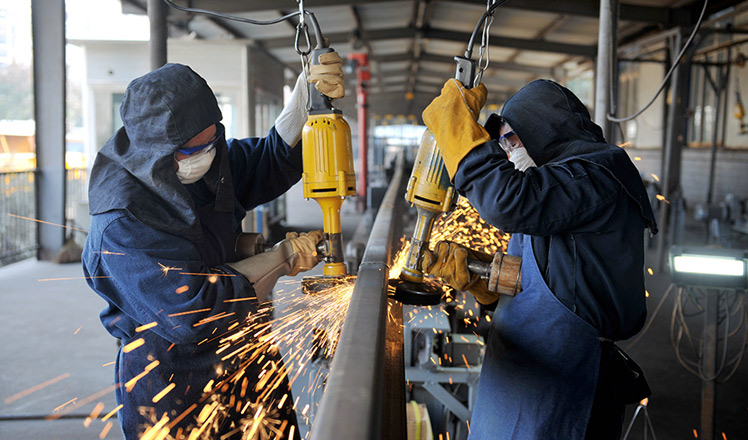Slower growth consistent with post-industrial era
Updated: 2016-02-18 14:18
By Dan Steinbock(chinadaily.com.cn)
|
||||||||
 |
|
Workers at an export-oriented mobile phone parts enterprise in Dongguan, Guangdong province. [Photo/China Daily] |
In 2015, China's economy grew by 6.9 percent. Internationally, the performance was portrayed as the "slowest in 25 years." Some argued that the slowdown reflected the eclipse of domestic demand. Others claimed it heralded China's "hard landing." And yet, the performance was within range of the government's official target of "about 7 percent."
What the deceleration signals is not China's demise, but the eclipse of Chinese industrialization.
Deceleration is normal
In the past, China enjoyed "double-digit growth." Today China's growth is slowing relative to its past performance. Historically, that is the norm, not the exception.
During intensive industrialization, most advanced economies have enjoyed relatively high growth. With the transition to post-industrial services, their growth has decelerated.
When the Industrial Revolution peaked in England in the early 19th century, the country experienced a "growth miracle." At the turn of the 20th century, US growth accelerated dramatically. After World War II, Western European economies had their growth miracles. A decade or two later, Japan followed in the footprints.
As these countries completed their industrialization and began to move toward a post-industrial society, growth acceleration gave way to deceleration.
What makes China different is its massive scale and the purposeful effort to shift from economic growth to rising living standards.
Rebalancing is not 'hard landing'
As China is "rebalancing," the economy is shifting from growth based on investment and net exports, which is not sustainable, to growth fueled by consumption and innovation, which is more resilient.
In the past, property markets drove the Chinese economy. However, last year real estate growth continued to decrease from almost 16 percent to 10 percent. The same goes for fixed-assets investment. Moreover, last December China's exports fell 1.4 percent on a quarterly basis, and imports slid 7.7 percent. Instead, services grew by almost 11 percent, faster than the industrial sector. Concurrently, retail sales of consumer goods - the key indicator of consumption - climbed over 11 percent on an annual basis. The services sector now accounts for over 50 percent of the Chinese economy. In 2015, Chinese consumption, which accounted for less than 40 percent of the GDP only half a decade ago, contributed nearly 60 percent to GDP.
- One of the two dead sperm whales in East China salvaged
- Paid menstrual leave provokes controversy in China
- MIT establishes supply chain education center in China
- 20,000 yuan eaten by ants gives artist a frame for inspiration
- Chinese military sets up corruption hotline
- Foreigners working in Beijing can now buy apartments immediately
- Britain scrambles fighters to intercept Russian bombers
- Chinese community to protest against Peter Liang's verdict
- Car bomb attack on military in Turkish capital kills 28
- Turkey's Erdogan says to fight forces behind Ankara bombing
- 'Grim Sleeper' murder trial begins six years after arrest
- Cameron defends EU deal as lawmakers offer no guarantees

 Madonna's world tour lands in Hong Kong
Madonna's world tour lands in Hong Kong
 Producing high-speed rail tracks
Producing high-speed rail tracks 
 Surreal world created by Canadian photographer
Surreal world created by Canadian photographer
 Lanterns light up the night across China
Lanterns light up the night across China
 Trees blossom across China as temperature rises
Trees blossom across China as temperature rises
 One of the two dead sperm whales in East China salvaged
One of the two dead sperm whales in East China salvaged
 Armless student pursues painting dream
Armless student pursues painting dream
 62-year-old folk artist carries on firecracker dragon lantern
62-year-old folk artist carries on firecracker dragon lantern
Most Viewed
Editor's Picks

|

|

|

|

|

|
Today's Top News
Will US-ASEAN meeting be good for region?
Accentuate the positive in Sino-US relations
Dangerous games on peninsula will have no winner
National Art Museum showing 400 puppets in new exhibition
Finest Chinese porcelains expected to fetch over $28 million
Monkey portraits by Chinese ink painting masters
Beijing's movie fans in for new experience
Obama to deliver final State of the Union speech
US Weekly

|

|








